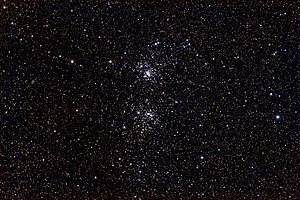Location of S Persei (circled) near the Double Cluster (north is left) | |
| Observation data Epoch J2000 Equinox J2000 | |
|---|---|
| Constellation | Perseus |
| Right ascension | 2h 22m 51.70928s[1] |
| Declination | 58° 31′ 11.4476″[1] |
| Apparent magnitude (V) | +9.23[2] (7.9 - 12.0[3]) |
| Characteristics | |
| Spectral type | M3 Iae–M7[3] |
| B−V color index | +2.65[2] |
| Variable type | SRc[3] |
| Astrometry | |
| Radial velocity (Rv) | -39.71[4] km/s |
| Proper motion (μ) | RA: –0.49 ± 0.23[5] mas/yr Dec.: −1.19 ± 0.20[5] mas/yr |
| Parallax (π) | 0.413 ± 0.017 mas[5] |
| Distance | 7,900 ± 300 ly (2,420 ± 100 pc) |
| Absolute magnitude (MV) | –6.36 (at mV 9.23)[2] |
| Details | |
| Mass | 20[6] M☉ |
| Radius | 1,298+64 −57[7] – 1,364±6[8] R☉ |
| Luminosity | 123,000[9] – 186,000[10] L☉ |
| Surface gravity (log g) | 0.0[11] cgs |
| Temperature | 3,000[12] – 3,600[10] K |
| Other designations | |
| Database references | |
| SIMBAD | data |
S Persei is a red supergiant or hypergiant located near the Double Cluster in Perseus, north of the cluster NGC 869. It is a member of the Perseus OB1 association and one of the largest known stars. If placed in the Solar System, its photosphere would engulf the orbit of Jupiter. It is also a semiregular variable, a star whose variations are less regular than those of Mira variables.
- ^ a b Cite error: The named reference
hipparcoswas invoked but never defined (see the help page). - ^ a b c Cite error: The named reference
levesquewas invoked but never defined (see the help page). - ^ a b c Cite error: The named reference
gcvswas invoked but never defined (see the help page). - ^ Cite error: The named reference
famaeywas invoked but never defined (see the help page). - ^ a b c Cite error: The named reference
asakiwas invoked but never defined (see the help page). - ^ Cite error: The named reference
yateswas invoked but never defined (see the help page). - ^ Norris, Ryan (2023). "Student Science at NMT: Learning Optical Interferometry Through Projects on Evolved Stars" (PDF). CHARA.
- ^ Norris, Ryan (2019). Seeing Stars Like Never Before: A Long-term Interferometric Imaging Survey of Red Supergiants (PhD thesis). Georgia State University. doi:10.57709/15009706.
- ^ Davies, Ben; Beasor, Emma R. (March 2020). "The 'red supergiant problem': the upper luminosity boundary of Type II supernova progenitors". MNRAS. 493 (1): 468–476. arXiv:2001.06020. Bibcode:2020MNRAS.493..468D. doi:10.1093/mnras/staa174. S2CID 210714093.
- ^ a b Cite error: The named reference
fokwas invoked but never defined (see the help page). - ^ Cite error: The named reference
gonzalezwas invoked but never defined (see the help page). - ^ Cite error: The named reference
GarciaHernandezwas invoked but never defined (see the help page).
